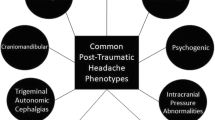Abstract
Purpose of Review
This article discusses the etiology and management of post-craniotomy headache and pain. A review of available as well as investigatory treatment modalities is offered, followed by suggestions for optimal management of post-craniotomy headache.
Recent Findings
There is a dearth of evidence-based practice regarding the differential diagnosis, natural history, and management of post-craniotomy headache. The etiology of post-craniotomy headache is typically multifactorial, with patients’ medical history, type of craniotomy, and perioperative management all playing a role. Post-craniotomy headaches are often undertreated, yet available evidence supports a multimodal approach for both prophylaxis and management. Many therapeutic techniques that aim to treat or prevent post-craniotomy headache require more robust validation than clinical evidence currently imparts. Pre- and intraoperative locoregional anesthesia should be the mainstay of prophylaxis; the role of opiates co-administered with analgesics, corticosteroids, and antiepileptic therapy in the acute perioperative phase is of paramount importance. Treatment of chronic PCH is less well-defined but should involve trials of analgesic, antineuropathic, and antiepileptic medications before enlisting experimental treatments. Comorbid psychiatric, musculoskeletal, or seizure disorders should be managed distinctly from post-craniotomy headaches. In patients failing all extant therapies, experimental approaches should be considered. These include subanesthetic ketamine infusion or surgical site injection with local anesthetics, corticosteroids, or botulinum toxin.
Summary
Post-craniotomy headache is a complex phenomenon with many underutilized treatment options available, and many more under investigation. Nonetheless, further research is required to differentiate the efficacy of contemporary treatment strategies and to elucidate the applicability of novel therapies.

Similar content being viewed by others
References
Papers of particular interest, published recently, have been highlighted as: • Of importance
De Benedittis G, Lorenzetti A, Migliore M, Spagnoli D, Tiberio F, Villani RM. Postoperative pain in neurosurgery. J Neurosurg Anesthesiol. 1996;8:315–6.
• Vadivelu N, Kai A, Tran D, Kodumudi G, Legler A, Ayrian E (2016) Options for perioperative pain management in neurosurgery. Journal of Pain Research 37. An in-depth review of the current available pharmacologic treatment options for neurosurgical pain.
• Haldar R, Kaushal A, Gupta D, Srivastava S, Singh PK (2015) Pain following craniotomy: reassessment of the available options. BioMed Research International 2015:1–8. A good review of the available pharmacologic treatment options for post-craniotomy pain.
Rocha-Filho PAS. Post-craniotomy headache: a clinical view with a focus on the persistent form. Headache: The Journal of Head and Face Pain. 2015;55:733–8.
Gray LCD, Matta BF. Acute and chronic pain following craniotomy: a review. Anaesthesia. 2005;60:693–704.
Ferreira KDS, Dach F, Speciali JG. Scar neuromas as triggers for headache after craniotomy: clinical evidence. Arq Neuropsiquiatr. 2012;70:206–9.
Potters J-W, Klimek M. Local anesthetics for brain tumor resection: current perspectives. Local and Regional Anesthesia Volume. 2018;11:1–8.
Schulte F, Filis A, Karageorgos N, Sandu N, Schaller B. Editorial Pain after craniotomy – really a problem? Arch Med Sci. 2010;6:827–8.
Brazoloto TM, Silvia Regina Dowgan Tesseroli De Siqueira, Rocha-Filho PAS, Figueiredo EG, Teixeira MJ, Siqueira JTTD (2017) Post-operative orofacial pain, temporomandibular dysfunction and trigeminal sensitivity after recent pterional craniotomy: preliminary study. Acta Neurochir 159:799–805.
Mackenzie HM, Teasell R, Miller TA, Sequeira K. Peri-incisional botulinum toxin for chronic postcraniotomy headache after traumatic brain injury: a case series. Pm&r. 2015;7:785–8.
Ranoux D, Martiné G, Espagne G, Salle H, Caire F. Delayed-onset post-craniotomy headache responsive to botulinum toxin A: a case series. Acta Neurochir. 2017;159:1375–8.
Banzi R, Cusi C, Randazzo C, Sterzi R, Tedesco D, Moja L. Selective serotonin reuptake inhibitors (SSRIs) and serotonin-norepinephrine reuptake inhibitors (SNRIs) for the prevention of tension-type headache in adults. Cochrane Database Syst Rev. 2015; https://doi.org/10.1002/14651858.cd011681.
Pomeroy JL, Marmura MJ, Nahas SJ, Viscusi ER. Ketamine infusions for treatment refractory headache. Headache. 2017;57:276–82.
Moisset X, Clavelou P, Lauxerois M, Dallel R, Picard P. Ketamine infusion combined with magnesium as a therapy for intractable chronic cluster headache: report of two cases. Headache: The Journal of Head and Face Pain. 2017;57:1261–4.
Lochte BC, Beletsky A, Samuel NK, Grant I. The use of cannabis for headache disorders. Cannabis and Cannabinoid Research. 2017;2:61–71.
Upadhya D, Castro OW, Upadhya R, Shetty AK. Prospects of cannabidiol for easing status epilepticus-induced epileptogenesis and related comorbidities. Mol Neurobiol. 2018;55:6956–64. https://doi.org/10.1007/s12035-018-0898-y.
Author information
Authors and Affiliations
Corresponding author
Ethics declarations
Conflicts of Interest
The authors declare that they have no conflicts of interest.
Human and Animal Rights
This article does not contain any studies with human or animal subjects performed by any of the authors.
Additional information
This article is part of the Topical Collection on Anesthetic Techniques in Pain Management
Rights and permissions
About this article
Cite this article
Lutman, B., Bloom, J., Nussenblatt, B. et al. A Contemporary Perspective on the Management of Post-Craniotomy Headache and Pain. Curr Pain Headache Rep 22, 69 (2018). https://doi.org/10.1007/s11916-018-0722-4
Published:
DOI: https://doi.org/10.1007/s11916-018-0722-4




